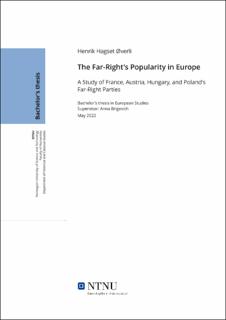| dc.contributor.advisor | Brigevich, Anna | |
| dc.contributor.author | Øverli, Henrik Hagset | |
| dc.date.accessioned | 2022-06-15T17:19:38Z | |
| dc.date.available | 2022-06-15T17:19:38Z | |
| dc.date.issued | 2022 | |
| dc.identifier | no.ntnu:inspera:110337431:49485007 | |
| dc.identifier.uri | https://hdl.handle.net/11250/2998922 | |
| dc.description.abstract | Den ytre høyresiden (eller populistiske radikale høyreparti) har blitt stadig mer populær det siste tiåret. Med Donald Trumps seier i 2016 og den nære seieren til Marine Le Pen in år, er det trygt å si at ytre høyre har blitt et veldig populært valg blant velgere over hele verden. Denne oppgaven skal undersøke hvorfor de har fått så mye popularitet. Nærmere bestemt Europa. Tidsrammen oppgaven fokuserer på er fra slutten av 1990-tallet til i dag. Oppgaven vil gå systematisk gjennom de høyreekstreme partiene i Frankrike, Østerrike, Ungarn og Polen og vise data som er knyttet til deres valgsuksess. Det konseptuelle rammeverket presenteres innledningsvis, data presenteres i midten og mulige forklaringer diskuteres i siste kapitel. Konklusjonen vil skissere funnene som er at høyreekstrem popularitet er knyttet til eksterne faktorer som landets økonomiske situasjon, immigrasjonsraten og antall flyktninger. | |
| dc.description.abstract | The far-right (or the populist radical right) has become increasingly popular in past decade. With the election Donald Trump in 2016 and the close, but ultimately, defeat of Marine Le Pen this year, it is safe to say that the far-right have become a very popular choice among voters across the world. This thesis is going to investigate why they have gained so much popularity. Specifically, Europe. The timeframe the thesis is focusing on is from the late 1990s to today. The thesis will go through the far-right parties of France, Austria, Hungary, and Poland systematically and show data that are connected to their electoral success. The conceptual framework is presented in the beginning, data is presented in the middle and possible explanations are discussed in the last chapter. The conclusion will outline the findings which is that far-right popularity is tied to external factors like the countries economic situation and the rate of immigration and refugees. | |
| dc.language | eng | |
| dc.publisher | NTNU | |
| dc.title | The Far-Right's Popularity in Europe: A Study of France, Austria, Hungary, and Poland's Far-Right Parties | |
| dc.type | Bachelor thesis | |
